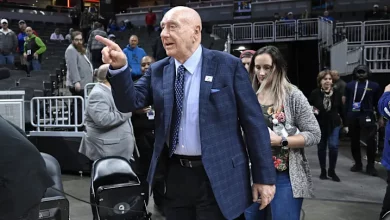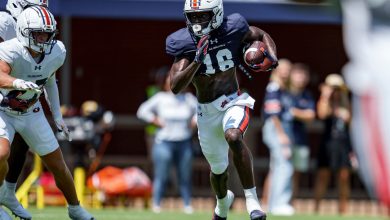Caleb Williams expressed understanding of fan anger amid frustrations over the $4.7 billion Bears stadium project, emphasizing the importance of fans’ support for the team’s future.

In recent weeks, a wave of frustration has been sweeping through Chicago’s sports community. The Chicago Bears’ ambitious plan to construct a $4.7 billion stadium has ignited debates among fans, city officials, and sports industry insiders. Amid mounting criticism, quarterback Caleb Williams, one of the most prominent young stars in the NFL and a future face of the league, made a notable statement expressing understanding of the fan anger while emphasizing the importance of support for the team’s future.
Williams’s comments have resonated beyond just his personal perspective, reflecting the complex intersection of sports, community interests, economic development, and team loyalty. To fully grasp the significance of his stance, it’s essential to explore the background of the stadium project, the reasons behind fan frustrations, Williams’s role and influence, and the broader implications for the Bears and the NFL.
The Context: The Bears’ Stadium Ambitions
The Chicago Bears have a storied history dating back to their founding in 1919. Over the decades, the team has experienced various periods of success and challenges, often intertwined with their home venues. For much of their recent history, the Bears have played at Soldier Field, a historic stadium with a capacity of approximately 61,500. While iconic, Soldier Field has faced criticism for its aging infrastructure, limited seating capacity, and inability to compete with modern NFL stadiums in terms of amenities and revenue potential.
In light of these issues, the Bears’ ownership has long considered relocating or constructing a new, state-of-the-art stadium to ensure the team’s competitiveness and financial viability. The current plan involves a massive $4.7 billion project to build a new stadium, likely in the Arlington Heights area, which promises not only a modern facility but also the potential for economic revitalization, increased tourism, and enhanced fan experience.
The proposed stadium is expected to feature cutting-edge technology, luxury suites, entertainment options, and extensive commercial development, aligning with NFL’s broader strategy to enhance fan engagement and revenue streams. However, such large-scale projects invariably attract criticism, especially when public funds, community concerns, and environmental impacts are involved.
Fan Frustrations and Concerns
While modernization and economic growth are compelling reasons for stadium development, fans and local residents have voiced significant concerns:
1. Public Funding and Economic Justification:
Many critics argue that stadium projects often rely heavily on public subsidies or tax incentives, raising questions about whether taxpayer money is being used responsibly. Despite promises of economic revitalization, studies often show mixed or minimal long-term benefits, leading to skepticism about the actual return on investment.
2. Displacement and Environmental Impact:
Large construction projects can lead to displacement of local residents, disruption of communities, and environmental concerns. Opponents worry about increased traffic, noise, and ecological footprint, particularly in suburban areas like Arlington Heights.
3. Cultural and Historical Significance:
Soldier Field is a Chicago landmark with historical importance. Moving or building a new stadium might be viewed as disregarding the city’s heritage, leading to emotional and cultural resistance.
4. Disappointment with Team’s Priorities:
Some fans feel the team’s focus on a new stadium signals misplaced priorities, especially when the on-field product sometimes struggles. They question whether investments should instead focus on roster improvements or community programs.
5. Transparency and Decision-Making:
Critics also accuse team owners and local officials of lacking transparency in negotiations, fueling mistrust and opposition.
These concerns have fueled protests, social media campaigns, and public debates, casting a shadow over the stadium project’s progress.
Caleb Williams’s Perspective: A Voice Amidst Controversy
In this contentious environment, Caleb Williams’s recent comments stand out. As one of the brightest young quarterbacks in the NFL poised to potentially be a franchise-changing talent, his words carry weight. Williams made it clear that he understands the frustrations of fans but also stressed the importance of unity and support for the team’s broader ambitions.
Key elements of Williams’s statement include:
- Empathy for Fans:
Williams acknowledged the passion and dedication of Bears supporters, recognizing that their frustrations stem from a desire to see the team succeed and thrive. - Focus on the Future:
He emphasized that investments in infrastructure, such as the new stadium, are aimed at building a stronger franchise that can compete at the highest level for years to come. - Support and Unity:
Williams urged fans to continue supporting the team, suggesting that their backing is vital for the team’s growth and success. - Personal Reflection:
As a player, Williams also expressed that he values the city, the fans, and the legacy of the Bears, promising to do his part to bring pride and excitement to Chicago.
Implications of Williams’s remarks:
His approach reflects a mature understanding of the broader dynamics at play. Instead of dismissing concerns or dismissing fan frustrations, he aligns himself with their passion, advocating for patience and collective support.
In a league where players increasingly engage with fans and community issues, Williams’s stance signals a recognition of his role as a leader, both on and off the field. It also signifies an awareness that NFL athletes are more than just performers—they are ambassadors for their teams and communities.
The Broader NFL Landscape: Stadiums, Fan Engagement, and Community Impact
The debate surrounding the Bears’ stadium project is not unique. Across the NFL, teams are grappling with similar issues:
- Modernization vs. Tradition:
Teams like the Raiders, Rams, and 49ers have undertaken massive stadium projects, often facing public debate about costs and community impact. - Public Funding Controversies:
Several NFL stadiums built or renovated in recent decades relied heavily on taxpayer money, sparking protests and legal challenges. - Economic Realities:
While proponents argue that new stadiums boost local economies, critics point to the often limited or temporary economic benefits. - Fan Experience and Revenue:
Modern stadiums aim to enhance fan engagement through luxury suites, immersive technology, and entertainment, which translate into increased revenue streams for teams. - Community and Cultural Considerations:
Teams are increasingly expected to be responsible corporate citizens, engaging in community development, environmental sustainability, and transparent decision-making.
The NFL’s approach to stadium development reflects these tensions, balancing financial interests with community concerns. The league’s leadership often advocates for collaborative solutions, emphasizing that successful stadium projects can benefit entire cities if executed thoughtfully.
The Role of Star Players Like Caleb Williams in Shaping Public Opinion
High-profile athletes have become influential voices in sports and social issues. Caleb Williams’s comments exemplify this trend. His empathy and focus on support can:
- Humanize Complex Issues:
By expressing understanding, Williams helps bridge the gap between fans’ frustrations and team ambitions. - Influence Fan Sentiments:
As a young, charismatic star, his words can sway public opinion, encouraging patience and unity. - Set a Positive Tone:
His approach fosters constructive dialogue, emphasizing that the team values its supporters even amid disagreements. - Encourage Community Engagement:
Williams’s stance can inspire other players and officials to prioritize transparency and community involvement.
Overall, his comments contribute to a more nuanced conversation about the future of the Bears and their place in Chicago’s social fabric.
Moving Forward: Balancing Progress and Community Concerns
The future of the Bears’ stadium project hinges on multiple factors:
- Negotiations and Transparency:
Ensuring open communication between team ownership, city officials, and the public can build trust. - Addressing Concerns:
Incorporating community feedback, environmental safeguards, and equitable development plans can mitigate opposition. - Demonstrating Long-Term Benefits:
Clearly articulating how the project will benefit Chicago residents—beyond just the team—can garner broader support. - Engaging the Fan Base:
Maintaining open channels for dialogue and involving fans in the planning process can foster a sense of partnership.









